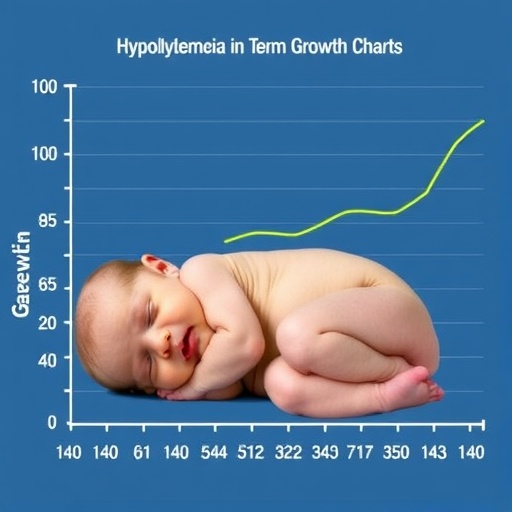
In the intricate and critical world of neonatal care, early detection of hypoglycemia in newborns remains a formidable challenge. Hypoglycemia, characterized by abnormally low blood glucose levels, poses significant risks to brain development and long-term neurological outcomes if not promptly identified and managed. A recent study published in the Journal of Perinatology delves into the efficacy of traditional growth charts in identifying at-risk well-term newborns for hypoglycemia, providing groundbreaking insights that could transform neonatal screening protocols worldwide.
Growth charts have long been fundamental tools in pediatric care, offering clinicians a visual and statistical reference to assess an infant’s size relative to a normative population. These charts typically quantify parameters such as birth weight, length, and head circumference, facilitating the recognition of deviations that might indicate underlying pathology or nutritional deficits. However, while these measures correlate with various health conditions, the direct applicability of growth charts in predicting neonatal hypoglycemia has remained ambiguous.
The recent investigation spearheaded by Khalil, D’Aversa, Lozy, and colleagues systematically evaluates the performance of widely utilized growth charts in identifying well-term neonates—those born between 37 and 42 weeks of gestation—who subsequently develop hypoglycemia. Unlike preterm or small-for-gestational-age infants, who are conventionally considered at higher risk, the focus on otherwise healthy term newborns underscores the nuanced challenges in early screening protocols. The researchers’ approach involved a comprehensive analysis of neonatal anthropometric data paired with glycemic measurements within the immediate neonatal period.
.adsslot_4e3Uu8zcPK{width:728px !important;height:90px !important;}
@media(max-width:1199px){ .adsslot_4e3Uu8zcPK{width:468px !important;height:60px !important;}
}
@media(max-width:767px){ .adsslot_4e3Uu8zcPK{width:320px !important;height:50px !important;}
}
ADVERTISEMENT
One of the study’s pivotal revelations concerns the limited predictive capability of standard growth charts in accurately flagging hypoglycemic risk among well-term newborns. Despite assumptions that deviations in birth weight percentiles—particularly infants classified as small-for-gestational-age (SGA) or large-for-gestational-age (LGA)—might correlate strongly with hypoglycemia incidence, the findings paint a more complex picture. Many neonates with normal weight percentiles still experienced clinically significant hypoglycemia, suggesting that reliance solely on growth parameters warrants reconsideration.
This insight challenges prior clinical paradigms, where growth charts have been used as primary screening tools to determine which infants should undergo routine glucose monitoring. The study emphasizes that while growth abnormalities remain important risk markers, they are insufficient as standalone indicators. Consequently, neonatal screening protocols might benefit substantially from integrating additional biochemical, genetic, or perinatal factors to enhance predictive accuracy.
Moreover, the research sheds light on the timing and threshold levels for hypoglycemia screening. The standard practice often involves glucose measurements at predefined intervals post-birth, sometimes triggered by growth chart assessments. However, this study’s data propose a more individualized timeline, as hypoglycemic episodes were found to manifest variably, irrespective of birth weight categorization. This variability underscores the necessity for dynamic, possibly continuous glucose monitoring technologies or refined clinical algorithms that transcend static anthropometric evaluations.
Technological advancements in neonatal care can play a pivotal role in translating these findings into practice. Emerging tools such as non-invasive glucose sensors and machine learning algorithms capable of synthesizing multifactorial risk profiles could revolutionize hypoglycemia detection. The study by Khalil et al. could act as a catalyst, promoting innovation aimed at developing integrated screening models combining growth data, maternal health parameters, perinatal stress factors, and metabolic indicators.
Importantly, the authors also highlight the clinical implications of their findings beyond the immediate neonatal period. Hypoglycemia, if unrecognized or undertreated, can precipitate a spectrum of neurodevelopmental disorders, including cognitive delays and motor impairments. Therefore, refining early screening methods not only aids in preventing acute complications but also contributes to optimizing lifelong health trajectories. This research elevates the urgency to revisit established protocols, ensuring that seemingly healthy term newborns receive comprehensive evaluation.
The study’s methodology merits attention for its robust cohort design and meticulous data collection. By restricting the sample to well-term newborns, the investigators controlled for confounding preterm-related metabolic issues. Additionally, the longitudinal follow-up through critical neonatal hours allowed a thorough characterization of hypoglycemic episodes relative to growth metrics. Such methodological rigor fortifies the credibility of their conclusions and provides a template for future studies targeting neonatal screening processes.
Expanding on the physiological underpinnings, the paper discusses the multifactorial etiology of neonatal hypoglycemia. While inadequate glycogen stores linked to intrauterine growth restriction remain a classical explanation, other contributing mechanisms, such as maternal diabetes-induced hyperinsulinemia or perinatal stress responses, reveal the condition’s complexity. This multifaceted pathogenesis challenges simplistic screening models based on growth patterns alone, advocating for a more holistic clinical perspective.
The study also prompts a critical reappraisal of the universal definitions and cutoff values for neonatal hypoglycemia. Existing guidelines vary in the glucose thresholds employed, with some using <40 mg/dL and others <45 mg/dL as critical. Khalil and colleagues stress that these arbitrary demarcations may need refinement, especially given the diverse metabolic profiles of term infants. Tailored thresholds informed by individual risk stratification might improve early detection and reduce both over- and under-treatment.
Furthermore, the investigation brings to light disparities in hypoglycemia outcomes related to demographic and socioeconomic factors. Although not the primary focus, preliminary data hint at variations in glucose monitoring practices and access among different healthcare settings. This aspect underscores the importance of equitable implementation of refined screening measures, ensuring that all newborns benefit from advances in neonatal care irrespective of external determinants.
In the broader context of pediatric healthcare, this study illuminates the evolving paradigm from population-based screening toward precision medicine. The inadequacy of traditional growth charts as solitary predictors exemplifies the need to incorporate multifaceted data streams and embrace technological innovations. Neonatology, often reliant on established clinical heuristics, stands on the cusp of transformation, poised to adopt data-driven, individualized approaches that enhance both diagnostic accuracy and therapeutic efficacy.
Looking ahead, the ramifications of this research extend to policy formulation, clinical training, and parental counseling. Updated guidelines reflecting nuanced risk assessment protocols will necessitate widespread dissemination and education among healthcare providers. Concurrently, empowering parents with informed knowledge about the limitations and strengths of current screening paradigms can foster collaborative care environments optimizing neonatal outcomes.
In conclusion, the study by Khalil, D’Aversa, Lozy, and their team signals a pivotal shift in neonatal hypoglycemia screening. By rigorously interrogating the role of growth charts in well-term newborns, the research challenges entrenched clinical assumptions and opens avenues for enhanced, multifactorial evaluation strategies. As neonatal medicine advances, integrating such evidence-based insights promises to mitigate the burden of hypoglycemia-associated complications, nurturing healthier beginnings for the most vulnerable patients.
Subject of Research: The efficacy of traditional growth charts in screening for hypoglycemia among well-term newborns.
Article Title: The performance of growth charts in well term newborns in screening for hypoglycemia.
Article References:
Khalil, M.A., D’Aversa, S., Lozy, T. et al. The performance of growth charts in well term newborns in screening for hypoglycemia. J Perinatol (2025). https://doi.org/10.1038/s41372-025-02373-3
Image Credits: AI Generated
DOI: https://doi.org/10.1038/s41372-025-02373-3
Tags: early identification of low blood sugarevidence-based neonatal screening practicesgrowth charts in newborn carehypoglycemia management in well-term infantsimplications of growth chart findingsJournal of Perinatology study insightslong-term neurological outcomes in infantsneonatal care advancementsneonatal hypoglycemia detectionpediatric growth monitoring toolsrisks of untreated hypoglycemiaterm newborn health assessments





